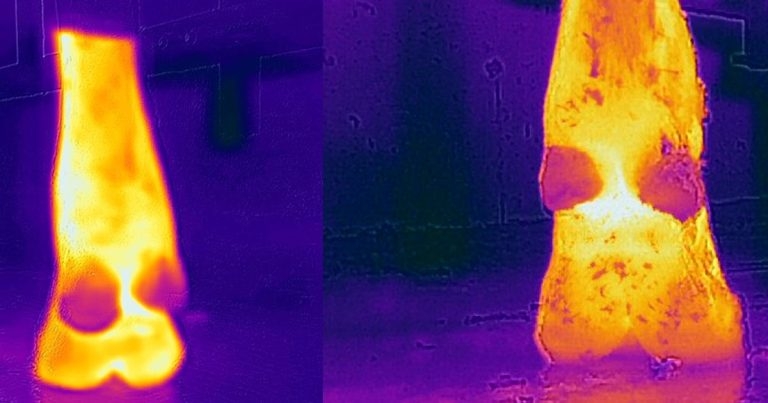22 Sept 2022
RVC research reveals low-cost devices could be as effective as diagnostics up to 50 times more expensive.

An image from the study, showing a thermogram from a low-cost thermal imaging device (left) and a thermogram from a high-cost thermal imaging device (right).
A study led by an RVC undergraduate has found low-cost thermal imaging devices could be as effective in detecting lameness in dairy cattle when compared with more expensive devices.
The study, published in Veterinary Sciences, highlighted the effectiveness of cheaper infrared thermal imaging devices in identifying the condition, and could lead to even wider use of the devices by farmers, vets and hoof trimmers to allow the condition to be identified earlier.
Lameness can affect between 20% to 25% of dairy cows nationally and costs the industry an estimated £53.5 million per year.
The study was led by RVC undergraduate veterinary student Aidan Coe, alongside Nicola Blackie, a senior lecturer in production animal science at the RVC, and compared the thermal images of 83 cows’ hind feet, captured with both high and low-cost thermal imaging devices.
Little difference was identified in the performance and quality of the devices, even though the cost of one was 2% that of the high-cost device.
The images captured suggested low-cost thermal imaging devices would be the most cost-effective choice to aid in the identification of lameness.
Mr Coe, lead researcher on the paper, said: “There is a possibility that low-cost infrared thermal imaging devices could be used as an objective, cost-effective method of assessing the lameness of the national herd, which may prove a useful adjunct to the current lameness detection methods.”
Dr Blackie added: “This project has the potential to make early detection of lameness in cattle accessible to more of the farming population, with great economic and welfare benefits.
“By demonstrating the almost equal effectiveness of lower-cost thermal imaging devices to that of more expensive equivalents, this study helps make this technology available to much more of the farming population.”